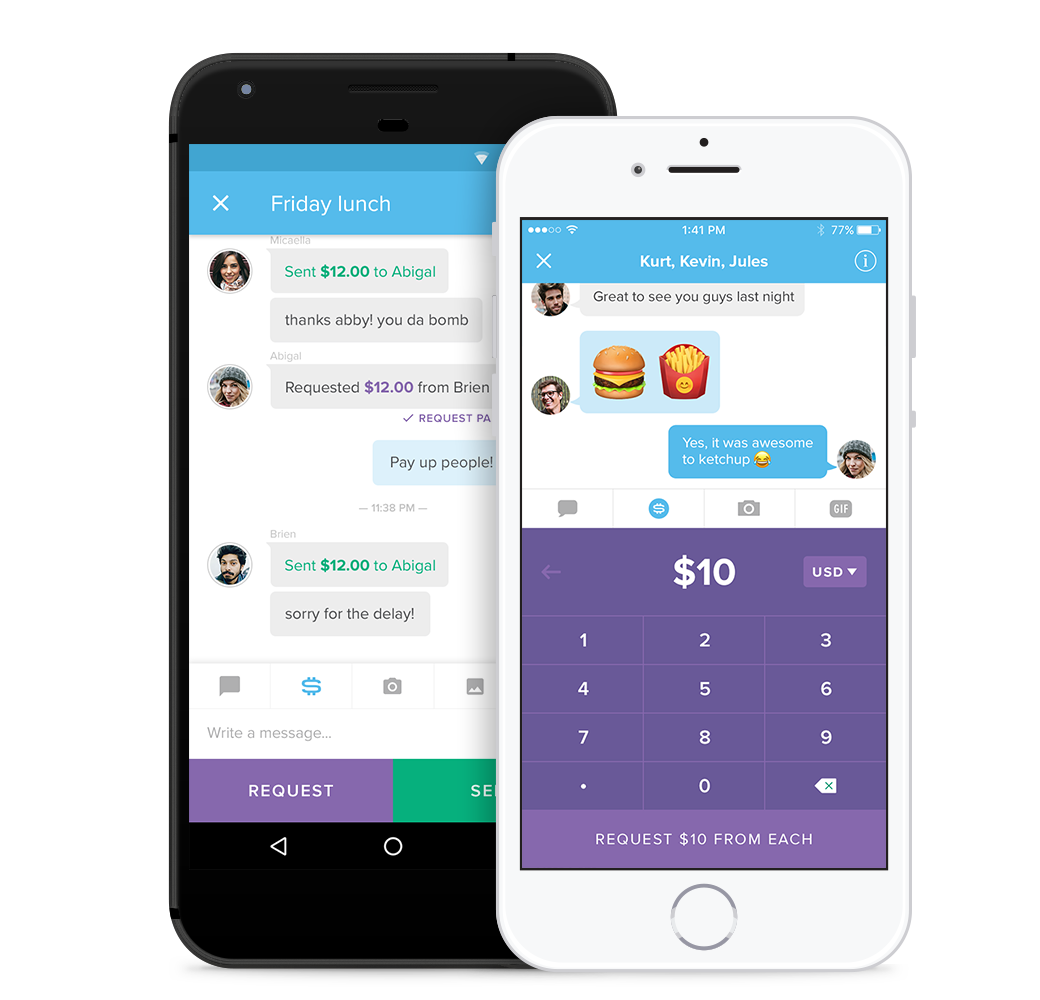Today people in France and Italy, and soon every country in the European Economic Area, join the millions of others who can use Circle Pay to send and receive money instantly within and across borders, directly to individuals or in larger social groups, across Android and iOS devices as well as across currencies, with no fees and zero markup on foreign exchange rates.
You can expect to send or request money as easily as you text, email, or share photos: for free, instantly, and without borders. Money today is also social, more than just transactions, which you can experience using Circle Pay’s money message, emoji, photo, GIPHY — and now new group and event features to share money among teams, clubs, roommates, friends, family, and other groups in the context of life’s moments and events.
Behind the scenes, Circle Pay is built upon the vision that open global protocols are emerging to make money work the way other kinds of content already work on the internet, and that global wallets and financial services will be interoperable with one another in the same way that different competing email apps can all use standard protocols to send email to one another.
Blockchain technology and crypto assets — including ethereum, bitcoin, and other tokens and cryptocurrencies — accelerate the emergence of these new finance protocols and remain critical to realizing this vision of open global financial services. So we’re also sharing more information about our crypto asset trading growth, how institutions may reach our trading service today, how it benefits people using Circle Pay, and how forthcoming new Circle services may help people everywhere tap into it in the future.
France and Italy Launches, EU Availability
Today social payments officially arrive in France and Italy, and enter early access in even more European countries: Belgium, Bulgaria, Denmark, Greece, Hungary, Iceland, Lithuania, Norway, Romania, Sweden, and Switzerland.
Since first entering Europe via Ireland and the United Kingdom last year, Circle Pay has spread the concept of zero-fee/zero-margin social payments across 29 European countries including: Spain, Austria, Croatia, Czech Republic, Estonia, Finland, Germany, Liechtenstein, Luxembourg, Netherlands, Poland, Portugal, Slovakia and Slovenia.
By the numbers, this expansion has meant customer growth in Europe of more than 800 percent year-over-year, and payments volume has grown by more than 700 percent in Europe alone in the past year.
Social payments enable people to send money the same way they send texts or post to social media on the internet: it is fluid, easily shared using a mobile phone number or email address, ignores the concept of borders (when is the last time anyone sent a “cross-border” email?), and is social and even delightful rather than awkward or utilitarian.
This new way of thinking about money and payments, which was born in China where it is now common across demographics, is especially interesting to millennials in the West. In Europe, 90 percent of Circle Pay customers are under the age of 35, and 60 percent are not yet 25 years old.
Social Money Messages for Groups and Events
In Circle Pay, payments flow naturally from social interactions. Sometimes we need to message money as part of a group conversation, such as a group of friends contributing to a meal, or a group renting a house together. Other times we need to pool money for a particular event, like a concert, a party, a trip, or a fundraiser. We can do both of these things much more easily through Circle Pay’s new group and event features, which roll out to more customers starting this week.

Using groups, you will be able to request and send money in a single group conversation among your teammates, friends, dinner companions, roommates, and other social groups. Money threads the group chat just like text, social media posts, photos, emoji, and images.
Using events, you can create a destination to host payments for your cause, goal, party, trip, team, or any other event. To learn more about events, take a look at this article in our Help Center.

These new additions join existing features transforming transactions into personal communications — like money messaging, sending and requesting money using photos and emoji, and similar touches. And like all of these features, groups and events work across iOS and Android, so friends can use whichever platform they prefer, and across currencies, so sending sterling to someone receiving euros means an instant zero-cost conversion.
Global Money Protocol Standards
Just as most of us don’t see the details of HTTP when we browse the web, or the details of SMTP when we send an email, most people don’t need to see the internal details of protocol standards for value exchange in order to benefit from zero-fee, zero-margin, instant and global social payments.
But just as in the web and email examples, the underlying existence of standard infrastructure is critical to breaking down the barriers and gateways that historically prevented us from connecting to one another globally and sharing and evolving our media, our opinions, our art and our science — and now, our economics and our expectations for how money works.
While a person who is sending euros from one digital wallet in France to someone else who receives that money as rupees in a competing digital wallet in India does not need to see the details of the settlement in transit, both people still benefit immensely from the inherent power of these new protocols by virtue of that instant, no-cost, secure interaction.
An open internet of value exchange can transform and integrate the world more deeply, eliminate artificial economic borders, and enable a more efficient and inclusive global marketplace that connects every person on the planet.
Key to these emerging protocols are:
- Technical innovations including distributed ledgers and blockchain technology which improve settlement infrastructure, trust and risk management, and contract execution; and
- Economic innovations such as the crypto assets — bitcoin and ethereum as well as numerous other tokens — that provide new economic incentives and capital rewards for adopting these new protocols and participating in their networks and growing their usage.
Circle Pay was built on this vision, and it depends upon both the development of the protocols and upon the value of crypto assets in order to grow its reach and continue to benefit more customers — even though Circle Pay customers may not interact with the protocols or assets directly in that particular payment experience.
Circle is deeply committed to the development of these new protocols. We shared a bit about our work on this infrastructure in previous posts, and more information about specific release plans, including contributions to existing systems as well as a major new open source project we plan to present, is forthcoming.
Circle is also deeply committed to the crypto asset component — not only as support for Pay and other potential consumer products, but also directly today as one of the world’s largest crypto asset market makers. We manage this through our trading services, which we want to highlight again here:
Circle tops $2 Billion in Crypto Asset Trading in August
Over the past four years, Circle has built a treasury and trading operation that spans crypto as well as fiat currency markets. Circle actively trades and provides significant market liquidity for bitcoin, ether, xrp and other crypto assets. We actively make markets on major crypto exchanges and provide significant scale in over the counter (OTC) trading with large natural buyers and sellers of crypto assets. The growth is significant — last month (August 2017) Circle directly traded over $2 billion in crypto assets.
With the recent explosion of interest in digital assets around the world, this activity has expanded, and Circle is actively taking on more and more trading counterparties.
A circle of network effects is in motion: the crypto asset trading business bootstraps and supports the value of the underlying token-fueled protocol and network; this grows the reach of the products and services built on top of that network (such as Circle Pay) to the benefit of all of us as consumers; the increasing usage and growth of those products and services in turn further grows the value of the crypto assets which fuel the network, which naturally grows the trading business — in a repeating cycle.
The market for crypto assets is also maturing and attracting broad interest as a more mainstream category for investment and wealth management, beyond the expert investors and institutions.
To that end, you can expect us to expand Circle’s consumer product design capability, loved by Circle Pay customers today, and connect it to our trading capability. More soon!
Next
We live in a world of open, connected, global and free communication and information sharing. The open internet — a global, distributed network of computers that share common open software protocols — has enabled billions of humans to connect and share information instantly, securely and with zero consumer cost. The implications for the world have been profound.
The invention of cryptographic assets and blockchain-based computing and data sharing have ushered in the next major era of the open internet. The implications promise to be at least as profound, and are just beginning to unfold.
We’re excited to experience this global evolution with you.
~ Sean and Jeremy, Circle Co-founders